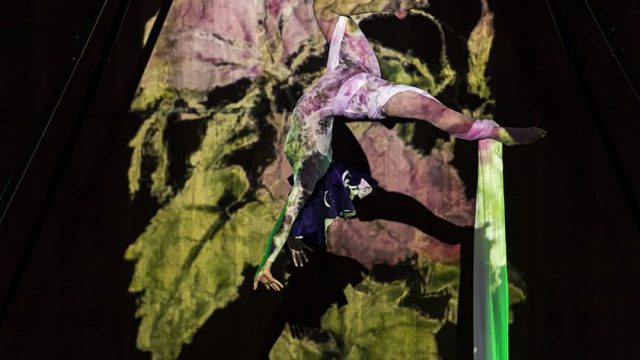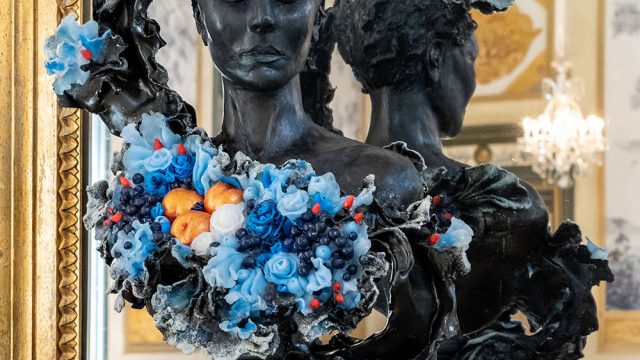 It has been totally fascinating to witness senior textile conservator, Elizabeth-Anne Haldane’s meticulous conservation of this beautiful piece over the last year or so. In this short film she describes some of the processes involved. The images below give a little more detail.
It has been totally fascinating to witness senior textile conservator, Elizabeth-Anne Haldane’s meticulous conservation of this beautiful piece over the last year or so. In this short film she describes some of the processes involved. The images below give a little more detail.  In recent history, small remedial patches (some taken from the original tunic) had been stitched to the inside of the garment to cover holes in the cloth to ‘improve’ it’s appearance. All these, and any other wrongly pieced sections, were methodically unpicked by Elizabeth-Anne to allow the true condition of the garment to be seen. The numbered fragments were then carefully laid flat on acid free tissue paper, Rigorous detective work enabled the pieces to be replaced back into their correct original positions within the whole structure of the garment.
In recent history, small remedial patches (some taken from the original tunic) had been stitched to the inside of the garment to cover holes in the cloth to ‘improve’ it’s appearance. All these, and any other wrongly pieced sections, were methodically unpicked by Elizabeth-Anne to allow the true condition of the garment to be seen. The numbered fragments were then carefully laid flat on acid free tissue paper, Rigorous detective work enabled the pieces to be replaced back into their correct original positions within the whole structure of the garment.  This Egyptian tunic was originally used to wrap a corpse in burial, the brown stains are the result of human decay. Although the garment is recognised as being in remarkably good condition considering it’s age and use, much of the fabric is extremely fragile. It needed to be structurally supported before it could go onto public display. An extremely fine synthetic gauze, specifically dyed to match different parts of the garment, was laid above and below the weak sections. Where the two layers of gauze cross a worn hole (right) they are invisibly stitched together, so stabilising the area.
This Egyptian tunic was originally used to wrap a corpse in burial, the brown stains are the result of human decay. Although the garment is recognised as being in remarkably good condition considering it’s age and use, much of the fabric is extremely fragile. It needed to be structurally supported before it could go onto public display. An extremely fine synthetic gauze, specifically dyed to match different parts of the garment, was laid above and below the weak sections. Where the two layers of gauze cross a worn hole (right) they are invisibly stitched together, so stabilising the area.  The tunic is dated to around the 8th century. During this period the tapestry sections which decorate the garment were woven separately and then stitched in place onto the base fabric. I want to know… did the same person weave the tapestry sections as the plain weave base cloth? The fine supporting conservation gauze is attached to about half the area seen in the left hand image. Even though I was standing right over the piece, I could barely see which sections were covered and which not, they had to be pointed out. A close detail makes visible the fine gauze which is attached to the most delicate parts. Worn sections of weave and broken warp threads, leave the weft extremely vulnerable. Each thread is invisibly couched down to prevent further unravelling. And here , three smiley faces…
The tunic is dated to around the 8th century. During this period the tapestry sections which decorate the garment were woven separately and then stitched in place onto the base fabric. I want to know… did the same person weave the tapestry sections as the plain weave base cloth? The fine supporting conservation gauze is attached to about half the area seen in the left hand image. Even though I was standing right over the piece, I could barely see which sections were covered and which not, they had to be pointed out. A close detail makes visible the fine gauze which is attached to the most delicate parts. Worn sections of weave and broken warp threads, leave the weft extremely vulnerable. Each thread is invisibly couched down to prevent further unravelling. And here , three smiley faces…  The Egyptian weaver would have thought and walked every single inch of thread through their fingers when making this fine textile. Well over a thousand years later, on this side of the world, the textile conservator is the only other person who can ever really know these fibres in such close detail. It is, a very intimate knowledge.
The Egyptian weaver would have thought and walked every single inch of thread through their fingers when making this fine textile. Well over a thousand years later, on this side of the world, the textile conservator is the only other person who can ever really know these fibres in such close detail. It is, a very intimate knowledge.
An Intimate Knowledge
0 comments so far, view or add yours
Please read our privacy policy to understand what we do with your data.


